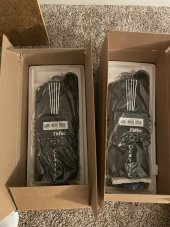Yeah I realize the EMP-hardening buzz word is for giving people more peace of mind (perhaps a lot to justify burning more money and give the warm-fuzzies). As I said, most of our co-op shareholders like the idea of having that peace of mind built into their setups. I wasn't really sold on that methodology though, since those inverters cost so much for one (and single point of failure if you only have one), they could still blowout due to some 'normal' failure and they wouldn't be able to quickly get a spare for replacement, and be back up and running swiftly.
I just went with MPP (pair of them, for a little extra redundancy at least on the 120v side of things) as I think it's a good solid 'cheap' inverter setup, made in Taiwan, but reputable manufacturer, haven't really heard about failures on them as far as I know.
I was thinking about also getting a couple of Growatts with the auto-transformer for the shop, just to have more 'spares' sitting around. Might even get an inverter just to keep in the faraday container if I thought it was that big of deal and I had some extra cash laying around someday. Or if I upgrade to some other inverters later, can keep a decomm'd pair as more spares.
One of my strategies for potential EMP hardening is just to try and run as much stuff off raw DC power as I can like lighting, motors, etc, try not to use the inverter for much if anything, have spare parts like extra BMSs and other parts like bulbs and motors, that are cheaper cost, sitting in my faraday container, keep a bunch of candles around in case that doesn't work for some reason.
If the parts are cheap price, then I can afford to have more spares lying around. Which is good for when you have a sudden 'normal' failure on Christmas Eve say, then you can go dig around in your faraday box parts bin and find something to get back into operation quickly, then go order the permanent replacement when you can. Or even to help a neighbor if they have a blowout.
It's the same reason why I have 8 older vehicles (instead of one new one), so if one gets a problem, I just take it out of the loop, use other vehicles while I'm fixing that one comfortably at my leisure. I also keep two extra spare iPhone SEs laying around, even restored with my backup image on them, so if mine decides to puke out (which has happened before on a few occasions), then I can swap the SIM and back up in 5 minutes, and figure out fixing the broken one later. I keep spare laptop, spare tools, pretty much spare everything on necessities.
For me, redundancy gives me the warm-fuzzies (no single point of failure) hehe...



